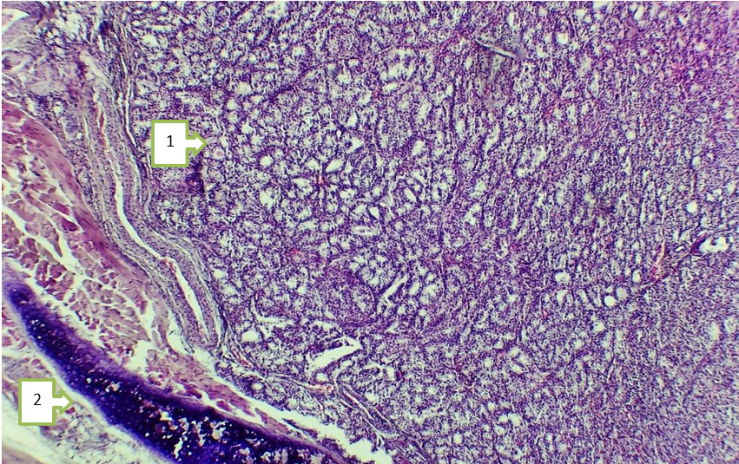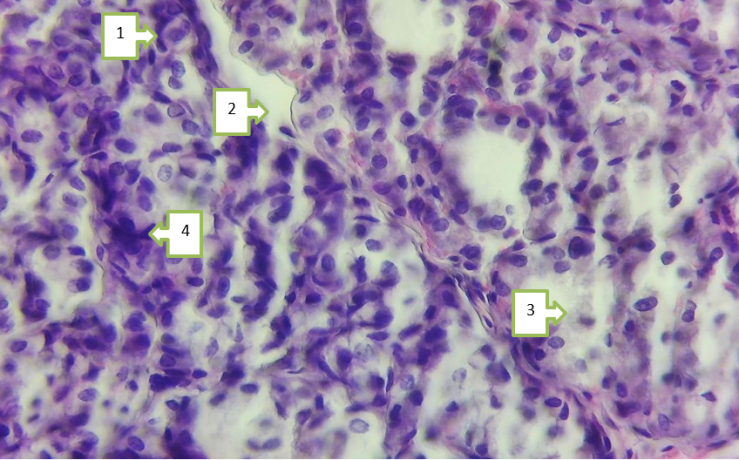-
Paper Information
- Next Paper
- Paper Submission
-
Journal Information
- About This Journal
- Editorial Board
- Current Issue
- Archive
- Author Guidelines
- Contact Us
American Journal of Medicine and Medical Sciences
p-ISSN: 2165-901X e-ISSN: 2165-9036
2024; 14(1): 129-132
doi:10.5923/j.ajmms.20241401.29
Received: Nov. 27, 2023; Accepted: Jan. 5, 2024; Published: Jan. 26, 2024

Characteristics of Morphological Changes in the Thyroid Gland When Experimental Pneumosclerosis is Induced
Karimova Muattar Sharipovna, Teshayev Shukhrat Jumayevich
Bukhara State Medical Institute, Uzbekistan
Correspondence to: Karimova Muattar Sharipovna, Bukhara State Medical Institute, Uzbekistan.
| Email: |  |
Copyright © 2024 The Author(s). Published by Scientific & Academic Publishing.
This work is licensed under the Creative Commons Attribution International License (CC BY).
http://creativecommons.org/licenses/by/4.0/

Introduction. According to statistics from the World Health Organization (2023), from 10 to 30 percent of the world's adult population suffers from various thyroid diseases associated with thyroid gland dysfunction and changes in its structure. The increase in the number of thyroid diseases in the world is 5% per year. Currently, along with diabetes, thyroid gland pathology occupies a leading place in the frequency of occurrence among endocrine diseases. Material and methods. In order to carry out experimental research, 4-month-old white male rats weighing 164-172 g were selected. All laboratory animals were obtained from the same vivarium and were performed on non-white rats up to 4 months of age. These adult (4-month-old) white rats were kept under standard vivarium conditions with relative humidity (50-60%), temperature (19-22°C) and light regime. Research results. After ethically decapitating all studied white rats belonging to both comparison groups, the rat carcass was dissected, the thyroid gland was removed from internal organs, cleaned and topographically and macroscopically examined. The thyroid gland of the intact group of white rats was examined morphologically. As a result of the study, no significant changes were visually observed in the external macroscopic appearance of the thyroid gland tissue of white non-breed rats belonging to the second group, morphological changes characteristic of neutrophilic inflammation appeared in the thyroid gland tissue during microscopic examination, it was observed that most of the cells changed and tumor appeared in the surrounding tissues (80.4%, n=22). Conclusions. When studying the results obtained from white rats in the group with experimental pulmonary pneumosclerosis, it was found that the number of microcirculatory vessels in the thyroid gland increased, i.e., the capillaries without compensatory activity were added, and the diameter of the vessels increased almost equally in the central and peripheral parts of the gland.
Keywords: Lung, Pneumosclerosis, Thyroid gland, White rats
Cite this paper: Karimova Muattar Sharipovna, Teshayev Shukhrat Jumayevich, Characteristics of Morphological Changes in the Thyroid Gland When Experimental Pneumosclerosis is Induced, American Journal of Medicine and Medical Sciences, Vol. 14 No. 1, 2024, pp. 129-132. doi: 10.5923/j.ajmms.20241401.29.
1. Introduction
- According to statistics from the World Health Organization (2023), from 10 to 30 percent of the world's adult population suffers from various thyroid diseases associated with thyroid gland dysfunction and changes in its structure. The increase in the number of thyroid diseases in the world is 5% per year. Currently, along with diabetes, thyroid gland (TB) pathology occupies a leading place in the frequency of occurrence among endocrine diseases [1].The occurrence of thyroid diseases is explained by many endogenous and exogenous factors. Among the most studied environmental factors is iodine intake [2,3].Long-term iodine deficiency causes QB diseases: diffuse and nodular / multinodular goiter, thyrotoxicosis against the background of nodular pathology of the thyroid gland, congenital hypothyroidism, mental and physical development of children, cretinism, abortion; significantly increases the risk of thyroid cancer due to exposure to radiation in the event of a nuclear accident. Autoimmune pathology of the thyroid gland (autoimmune thyroiditis and Graves' disease), as well as diffuse tooth development with excess iodine, are more characteristic for regions with sufficient or excessive iodine consumption [3]. Reversal of iodine deficiency reduced non-toxic goiter and congenital hypothyroidism [6]. However, even a slight increase in iodine intake in previously iodine-deficient populations alters the nature of the observed thyroid pathology in different directions [3]. On the one hand, diffuse and nodular goiter, congenital hypothyroidism and other iodine deficiency diseases are decreasing, and autoimmune pathology of the thyroid gland is increasing. On the other hand, a number of changes in the structure and function of the thyroid gland continue despite the increase in iodine content, which reflects not only the current, but also the previous state of iodine availability ("iodine memory" effect) [7].
2. Material and Methods
- In order to carry out experimental research, 4-month-old white male rats weighing 164-172 g were selected. All laboratory animals were obtained from the same vivarium and were performed on non-white rats up to 4 months of age. These adult (4-month-old) white rats were kept under standard vivarium conditions with relative humidity (50-60%), temperature (19-22°C) and light regime (12 h dark and 12 h light).In order to prevent infectious diseases in the vivarium and to ensure that they are free of infectious diseases, the laboratory animals were quarantined for 21 days and observed during these days, their temperature was measured and their weight was checked several times during these days. weight gain was monitored. During this period, no symptoms of illness were observed in them, their temperature was within normal limits (38.5-39.5°C), appetite disorders and other external changes were not detected. These cases showed that it is possible to involve them in experiments.Vivarium buildings were cleaned every morning, cages and rooms were cleaned in special clothes. The corpses of the animals that died during the experiment were buried in the soil, and the corpses of white-bred rats were chlorinated before the burial, after completing the relevant documents (certificate on the destruction of dead or killed laboratory animals). treated with a 20% solution of lime.Nuraliev N.A. in the preparation of standard vivarium food ration for laboratory animals. and all. (2016) based on the recommendations in the methodological manual. All biological safety rules and ethical principles of working with laboratory animals were strictly followed in keeping, killing and dissecting laboratory animals.Permission was obtained from the Ethics Committee of the Ministry of Health of the Republic of Uzbekistan to conduct experiments with laboratory animals (white rats).All laboratory animals were divided into two groups:the first group - control group - laboratory animals (n=20), healthy rats fed with standard vivarium ration;the second group - laboratory animals (n=30) fed with standard vivarium ration, lung pneumosclerosis was induced in them.Research methods widely used in experimental research were used to study the morphological parameters of the organs of laboratory animals (anatomical dissection). All histological preparations were viewed using an HL-19 trinocular microscope (China) with software. The main objects of the study were histological paraffin blocks prepared from the thyroid gland tissue of purebred rats and tissues cut on a microtome. Preparation of histological preparations consisted of 4 stages and was carried out by traditional methods. A YD-315 mechanical rotary microtome (China) was used to prepare the preparations, the prepared sections were stained with hematoxylin and eosin and viewed under a trinocular microscope.In laboratory conditions, the thyroid gland tissue of purebred white rats with pulmonary pneumosclerosis was isolated, the organ was fixed in a 10% neutralized formalin solution, frozen for 72 hours, then washed in running water for 2 hours, and then dehydrated with alcohols of increasing concentration. was carried out and blocks were prepared by pouring paraffin. Sections with a thickness of 5-8 μm were prepared from them, and the general histological structure was studied by staining with hematoxylin-eosin dye. Sections were studied under a Leica light microscope, and pictures were taken of the necessary areas. Micropreparations were photographed under a microscope with dimensions of 4×10, 10×10, 40×10, 100×10.
3. Research Results
- After ethically decapitating all studied white rats belonging to both comparison groups, the rat carcass was dissected, the thyroid gland was removed from internal organs, cleaned and topographically and macroscopically examined. The thyroid gland of the intact group of white rats was examined morphologically. As a result of the study, no significant changes were visually observed in the external macroscopic appearance of the thyroid gland tissue of white non-breed rats belonging to the second group, morphological changes characteristic of neutrophilic inflammation appeared in the thyroid gland tissue during microscopic examination. (100%, n=30), it was observed that most of the cells changed and tumor appeared in the surrounding tissues (80.4%, n=22).Micropreparations prepared from the thyroid gland tissue of laboratory animals suffering from pneumosclerosis of the lungs. As can be seen from the picture of the histological preparation on the given slide (pictures 1-2), morphological changes characteristic of inflammation have appeared in the thyroid gland tissue. (100%, n=30), changes in most cells and especially hyperplasia of S-cells (parafollicular cells), thickening of septa, engorgement of small blood vessels, stasis and edema in the perivascular area, hydropic of the thyroid epithelium (thyrocytes) dystrophy (72.2%, n=20), follicular hyperfunction: enlargement of the thyrocyte nucleus and hyperchromic staining were observed. These signs are typical signs of thyroid hypofunction. It was found that the size of the follicles decreased, the amount of colloid in the cavity of the follicles decreased, and the consistency of the colloid thickened. It was observed that the epithelium of the gland, which formed the wall of the follicles, decreased in size, increased due to the growth of the stroma consisting of intrafollicular and extrafollicular bridging tissue (due to the process of sclerosis, fibrosis).Pneumosclerosis - due to inflammatory or dystrophic process, excessive growth of connective tissues of the lungs, loss of elasticity and a decrease in gas exchange function of the affected areas. Traditionally, shortness of breath has been shown to be a constant symptom of diffuse pneumosclerosis, often with a tendency to develop. Changes in ventilation are characterized by restrictive breathing disorders. There are experimental models for the development of pulmonary fibrosis. The main difficulty in modeling permanent experimental pneumosclerosis is related to the multifactorial nature of the disease and its heterogeneity. The development of the disease is influenced by various factors that affect the small bronchi and cause the destruction of the lung parenchyma, which also affects the vascular system of the pulmonary circulation.
 | Figure 1. Normal microscopic appearance of the thyroid gland tissue of a white non-breed rat. 1. Thyroid gland cells. 2. Tracheal tissue. Paint G-E. ob 4×18 ok |
4. Conclusions
- It was found that the size of the follicles decreased, the amount of colloid in the cavity of the follicles decreased, and the consistency of the colloid thickened. It was observed that the epithelium of the gland, which formed the wall of the follicles, decreased in size, increased due to the growth of the stroma consisting of intrafollicular and extrafollicular bridging tissue (due to the process of sclerosis, fibrosis). When studying the results obtained from white rats in the group with experimental pulmonary pneumosclerosis, it was found that the number of microcirculatory vessels in the thyroid gland increased, i.e., the capillaries without compensatory activity were added, and the diameter of the vessels increased almost equally in the central and peripheral parts of the gland.Information about the source of support in the form of grants, equipment, and drugs. The authors did not receive financial support from manufacturers of medicines and medical equipment.Conflicts of interest: The authors have no conflicts of interest.
 Abstract
Abstract Reference
Reference Full-Text PDF
Full-Text PDF Full-text HTML
Full-text HTML